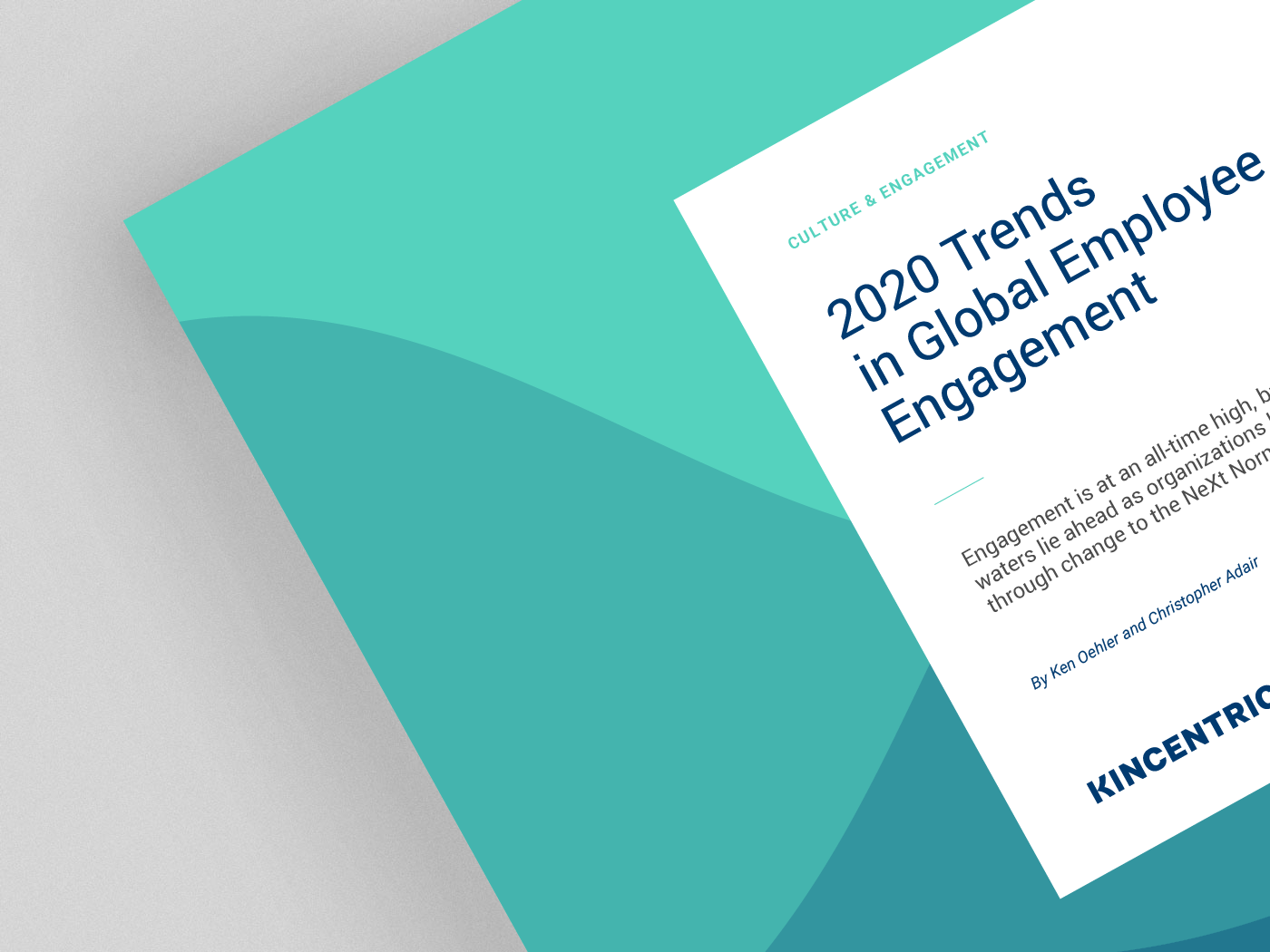
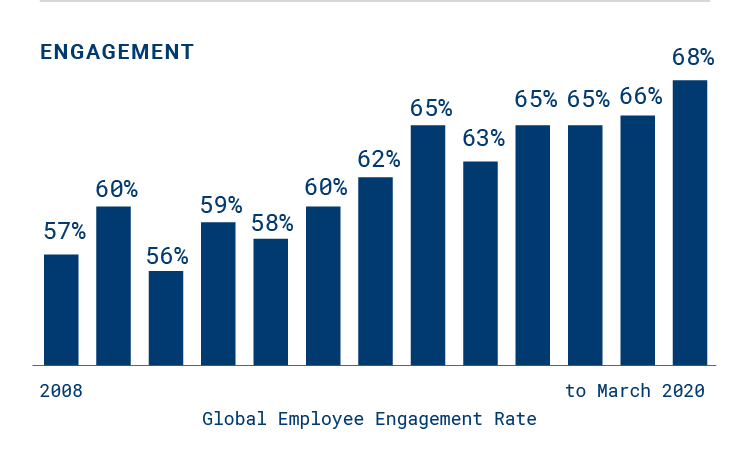
The first half of 2020 has been challenging to say the least, and has made an engaging employee eXperience (eX) more critical to driving performance than ever before. But in the wake of the challenges brought about by the COVID-19 pandemic, we have seen our clients’ employees become increasingly more engaged – now at an all-time high of 68 percent.1 We believe this reflects our clients’ strong attention to listening strategy and the leadership, Organizational Development/ Human Resources and change management interventions required to move the needle. However, as we will discuss shortly, this uptick in engagement in the context of COVID-19 may be difficult to sustain and likely to drop, following a similar pattern to what we saw in 2010 following the 2008/2009 financial crisis.
At a country level, we see that the driving force behind the global increase is due to the largest markets increasing, namely China (+4pts) as well as the U.S. and India (+2pts each). These increases outweigh drops in other large markets such as Brazil (-5pts), Saudi Arabia and France (-3pts each). Japan, where engagement normatively trends below other markets, saw a significant +11pt increase through March of 2020.
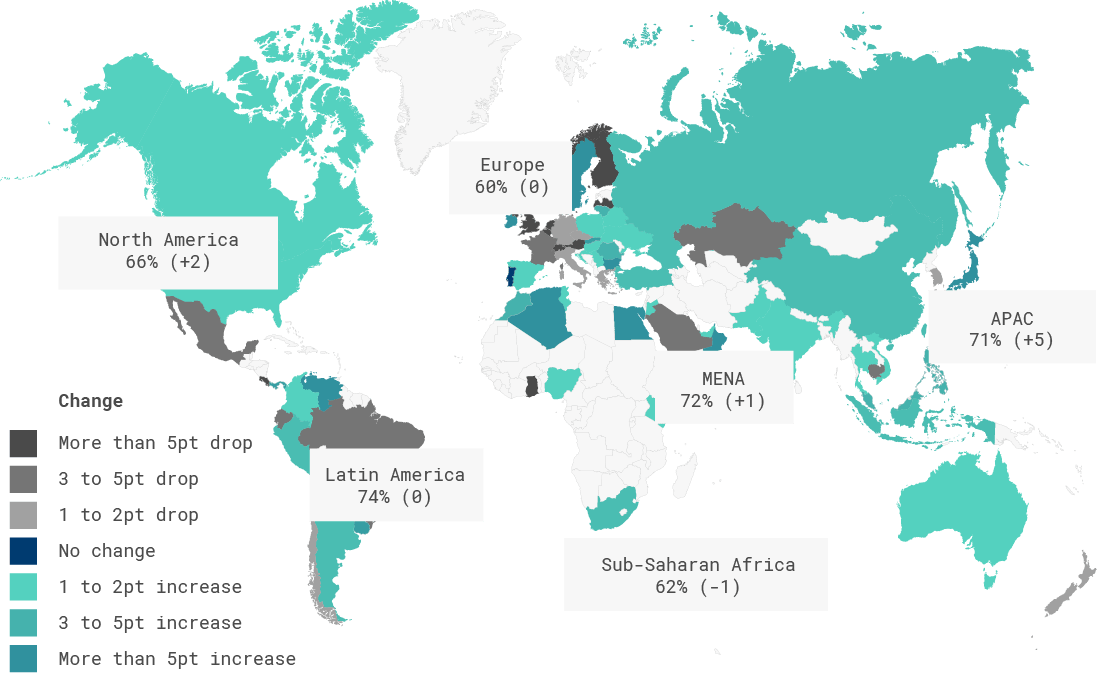
But these data represent engagement from the 2nd half of 2019 through Q1 of 2020. Obviously, as we enter into the second half of the year, we are in a very different world than we were a few months ago. How have things changed? First, organizations have had to be much more purposeful at communicating with employees, and this has led to dramatic increases in perceived effectiveness of communication, as we see on the figure below.2 There has also been a strong shift toward measuring employee well-being as opposed to (or in addition to) engagement. A focus on empathy and connection, particularly from managers and senior leaders, has also been measured more. Employees have reported increasingly favorable experiences in these two areas during COVID-19. This increase may be partially due to the increased attention and higher priority leaders have been placing on caring and compassionate outreach.



Engagement is at an all-time high. Employees’ perceptions of managerial and leadership care have never been higher. This all seems like good news. However, significant challenges lie ahead. We have seen similar “change curve” patterns in engagement following large-scale events shaping economic and labor conditions, and have identified key ingredients to Managing Engagement During Times of Change. Our chart depicting yearly engagement trends highlights this pattern following the financial crisis of 2008 — namely, where a short increase in engagement was followed by an equal or stronger drop. We discussed this trend at length in our 2010 Trends in Global Employee Engagement Report. Workforce uncertainty — with salary reductions and layoffs — coupled with more existential stresses outside of work will make the coming months and beyond challenging for individuals and organizations alike.
Employee Experience in the Context of Change
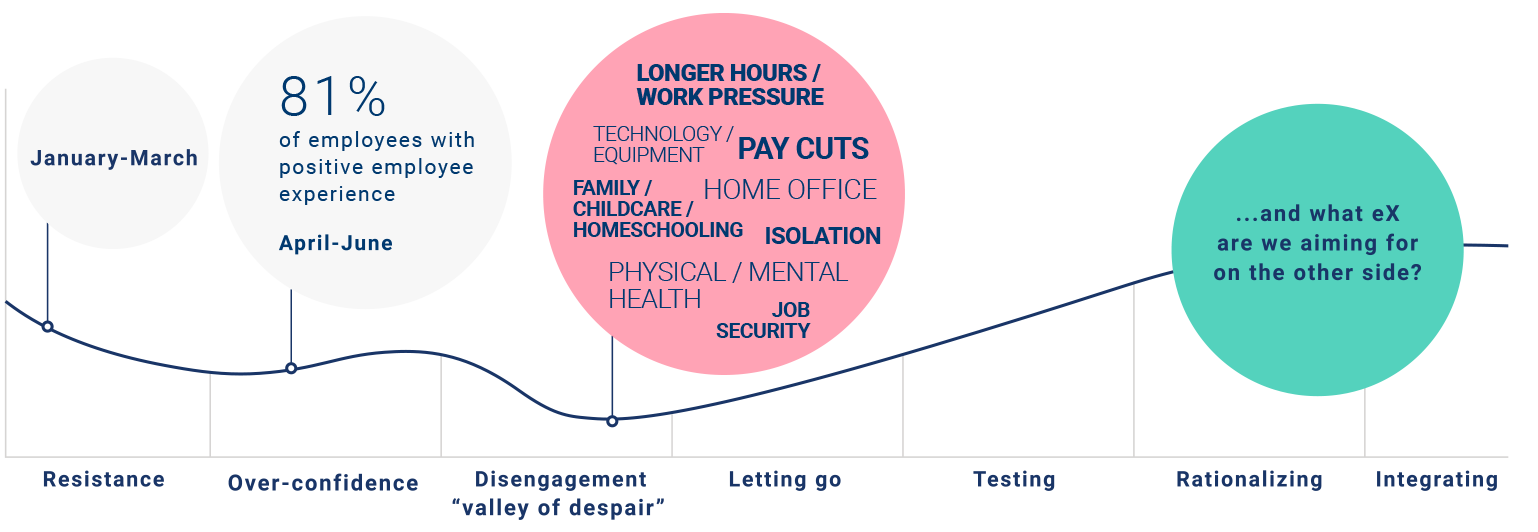
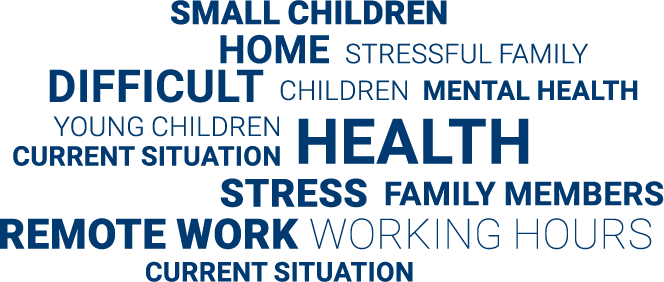
Understanding how people experience cycles of change along with comments from employees indicate we may have some tough times ahead. The mood cloud to the left is the output of natural language processing (NLP) summarizing the most negatively toned comments from our client pulse surveys in April and May.3 This shows stress and burnout will be significant risks for employees and employers moving forward. The cumulative impact of stress is real — both physical and mental — and employers need to ensure they have the capability and capacity to support employees.
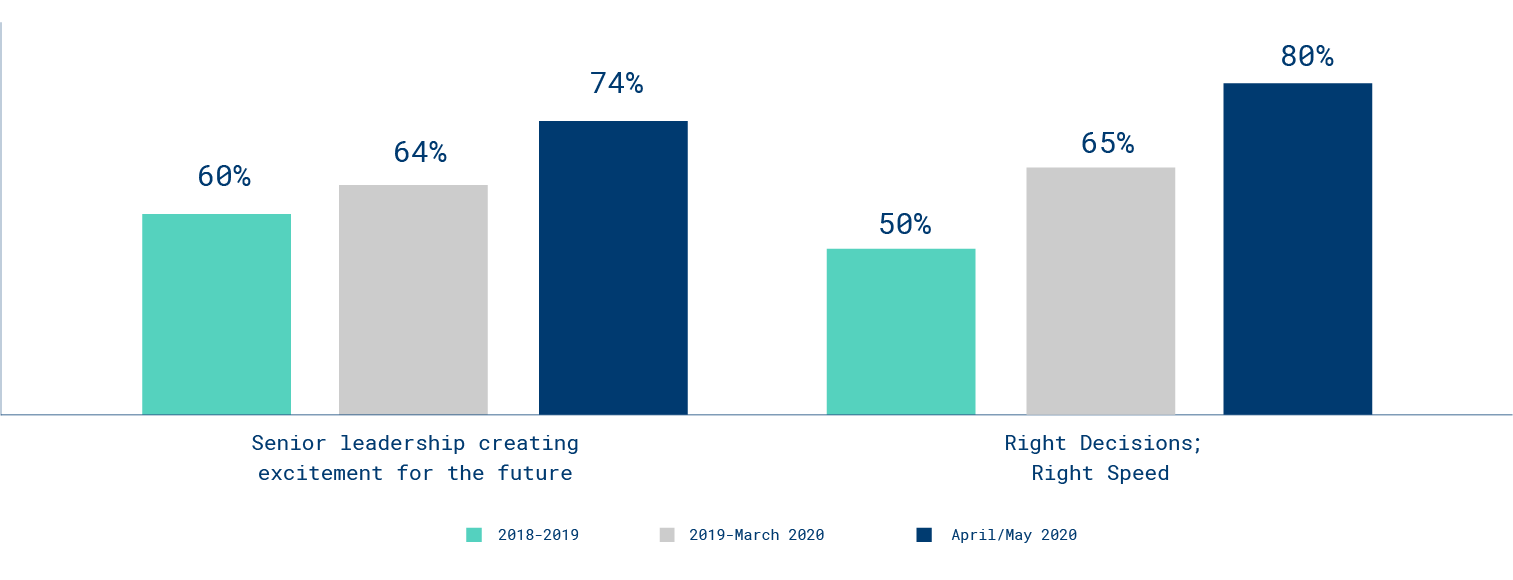

But there’s reason for optimism that organizations can overcome these challenges and deliver for their employees. We have seen a significant increase in effective decision-making (+15pts) and senior leaders creating excitement for the future (+4pts) in the past year, and these continued to increase through April-May during the peak of the COVID-19 pandemic4. This intersection of inspirational leadership and agile decision-making has been a key reason why some organizations have been able to successfully navigate 2020’s challenges. There has been a significant focus on Agility in many organizations over the last few years, but little did we know how important that was going to be in 2020. Now that we have realized the benefits of agile and inspirational leadership, the real question is: can we ever go back?
With rising levels of global employee engagement, leaders have the opportunity to leverage some of this “engagement equity” to sustain and drive engagement across the employee experience by focusing on moments that matter to the employee. Our decades of experience have shown us that the most powerful moments are those that inspire, elevate, connect and remove friction. The table below depicts the top ranked focus areas for driving engagement based on global employee data collected in the last year mapped against the top moments that matter from HR’s perspective (based on our 2020 Global Employee eXperience Research of 850 global HR professionals5).
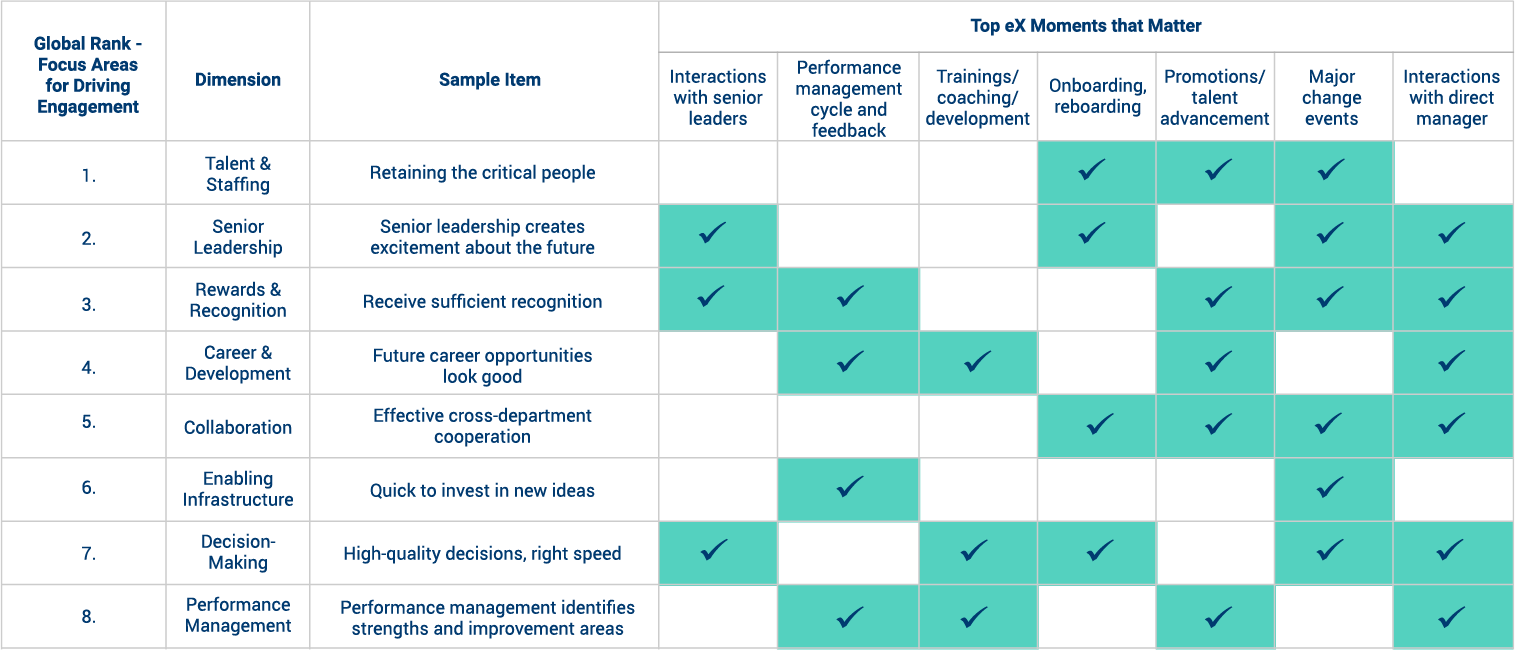
But engagement is not just a point in time or survey KPI. The top drivers indicate what employees need in order to be engaged throughout their experience at work. It is no longer (and likely never was) effective to set up action plans after a census survey, take a flurry of actions and wait for the next survey hoping that it shows those actions were effective. The goal of creating and sustaining an engaging employee experience is achieved through purposeful design and management of these moments to deliver what employees need most.
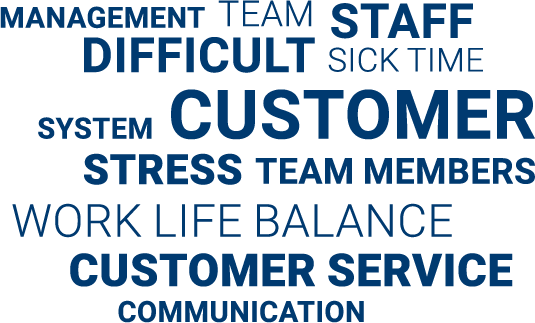
Using NLP to examine latent themes in comments from hundreds of global organizations in 2019-2020 across dozens of languages, we see that otherwise highly engaged employees are frustrated by several factors related to how the work gets done: processes, systems, and the balance between work and life. These employees also cite customers as an area of frustration — but these comments mostly reference frustrations with an inability to properly serve customers. Listening to constructive, actionable feedback from highly engaged employees is a critical element to creating an engaging employee eXperience.
Our current environment has significant uncertainty and stress. Layoffs, salary reductions and shifting business strategies have affected organizations and individuals alike, and at the time of writing this paper there is not a clear stabilization in sight. To establish a strong employee eXperience in the NeXt Normal, keep an eye on these trends:

Turn down the volume on engagement. This may sound like an odd thing to say in a paper about employee engagement, but companies are increasingly focused on other constructs alongside or instead of engagement — not necessarily as drivers in the traditional sense, but critical KPIs themselves. Two that will be increasingly important moving forward:
a. Well-being: to what extent are employees’ well-being, both physical and emotional, supported? What systems are in place to track, measure and improve?
b. Inclusion and Equity: The events of 2020 – from COVID-19 stressors to racial tragedies – have demonstrated the necessity for creating an environment which employees have a voice and feel accepted and valued. How can we create an experience that moves beyond diversity to true equity and inclusion?

Get purposeful about your measurement strategy. What are the most important moments for creating an engaging eXperience at your organization? What do employees need to stay safe, productive and engaged? How do you know? Generic measurement gets generic feedback. Having a specific, hypothesis- driven measurement strategy solicits more actionable suggestions for you and your leaders. If history repeats itself and the change curve is true, the experience is going to get more difficult and leaders will need ongoing insights, suggestions and faster feedback loops.

Double down on leadership development. Leadership care and concern was the #1 driver of employee well-being during our April/May COVID-19 pulses.6 Results from our 2020 Global eX Research from 850 HR executives and professionals suggest that the most critical behaviors for creating a great employee eXperience are inspiring and empowering the team, creating emotional connections, and demonstrating agility. These are no longer “nice to have” or “differentiating” – they’re required.

Accelerate HR for eX. Last year, we highlighted the need for HR to advance capability and capacity. That need has never been more evident. We must learn from the past months’ challenges to help build an employee eXperience informed by data. Again, our 2020 Global eX Research tells us that the top priorities for HR to drive an “outside-in” engaging employee experience are integration across HR functions, strong HR Shared Services and HRBP strategic capability.

Amplify an act-listen-adjust approach to continuous dialogue. The pulses during the COVID-19 pandemic were an excellent case study in continuous dialogue: they were a check-in to quickly help leaders understand how things are going and how to adjust after specific actions have been taken. This is dramatically different from the listen-analyze-action plan approach seen in many annual surveys or engagement pulses on repeat.
German Translation | Lesen Sie auf Deutsch
1 Results based on 9.4 million employee responses collected globally between April 2019 and March 2020.
2 Comparing responses from 250+ global companies from April/May 2020 to those collected pre-COVID-19 in H2 2019.
3 Based on analysis of pulse survey respondents across 250+ companies. These are the words with the most negative tone when we asked clients about what can be done to help them personally.
4 Questions asked during April-May were modified slightly to be more specific to COVID-19
5 2020 Global Employee eXperience Research
6 Top regression driver of employee well-being
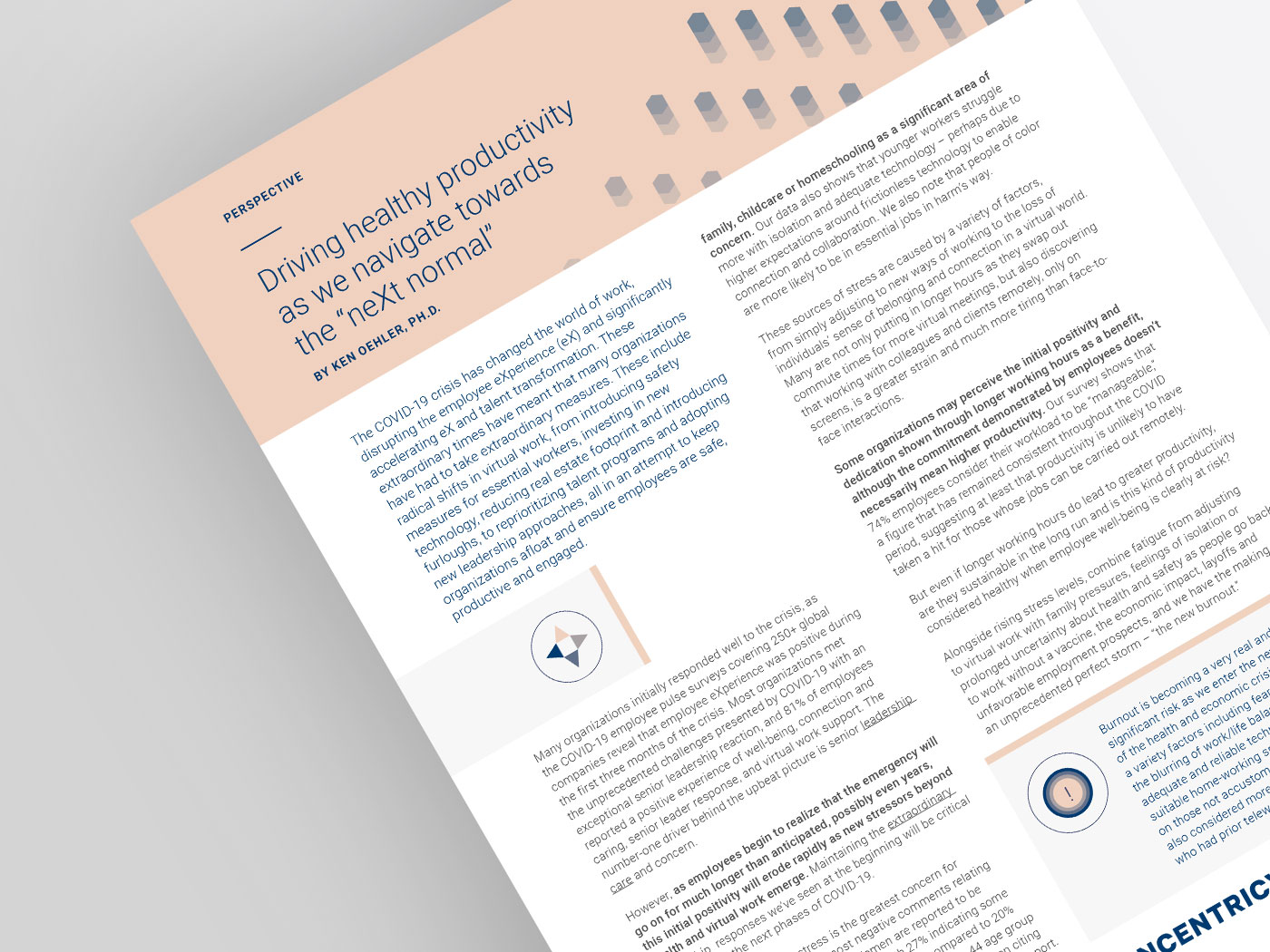

What matters the most in leadership is the unique connection forged between a leader and each and every individual member of the team.
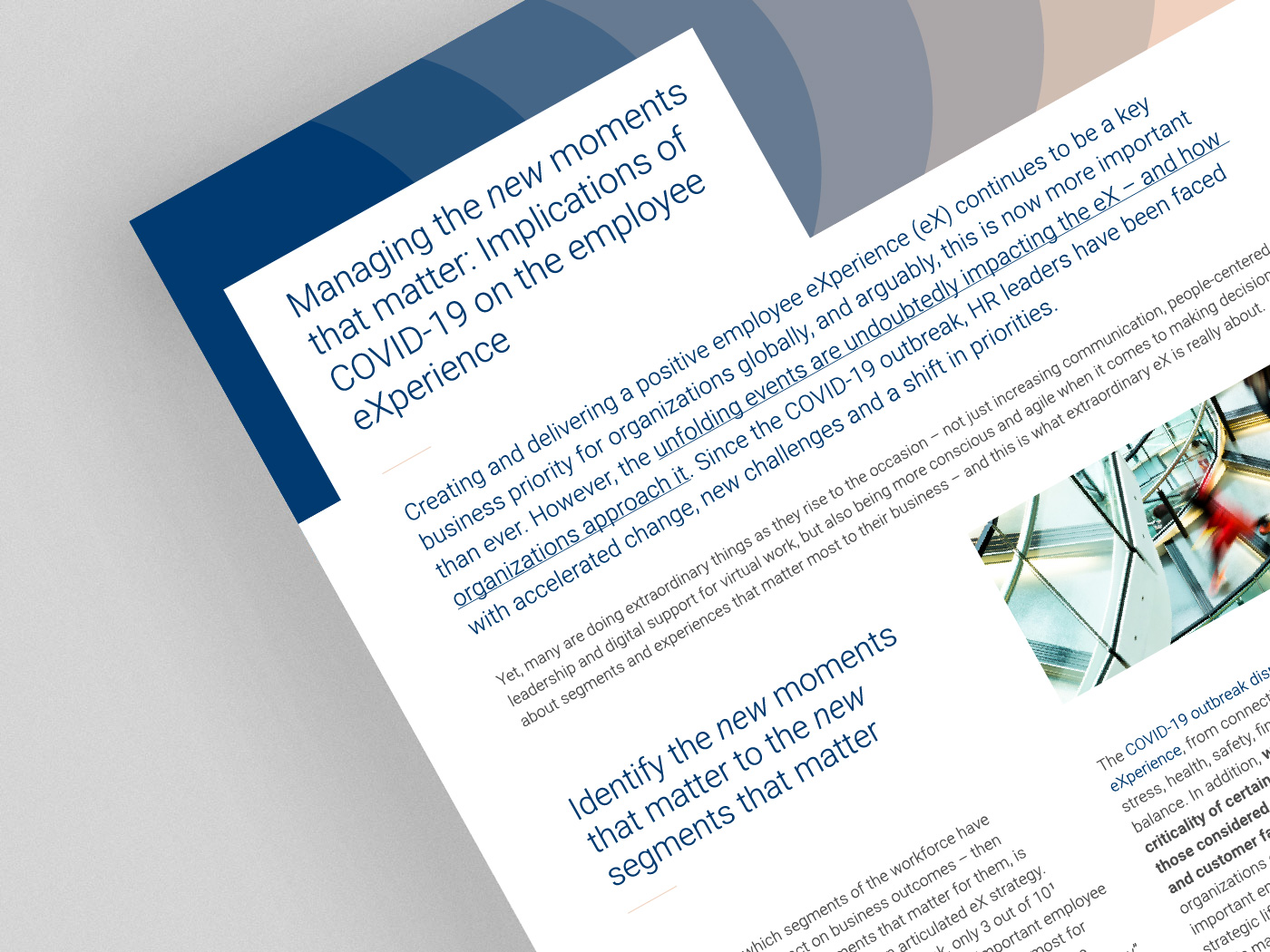
Creating and delivering a positive employee eXperience (eX) continues to be a key business priority for organizations globally.
Multiple translations are available.